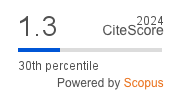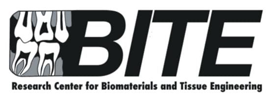Antibacterial and anti-adherence effect of Laportea interupta ethanolic extract on Streptococcus mutans biofilm
Downloads
Background: Due to its capacity to generate extracellular polymeric substances that aid in biofilm creation, Streptococcus mutans is a leading cause of dental caries. Natural remedies, including traditional plant extracts, are being explored for their antimicrobial potential. Laportea interupta (L. interupta), known as jelatang in Indonesia, is alleged to possess a bacteria-inhibiting effect. Purpose: The purpose of this study is to evaluate the potential use of L. interupta leaf ethanolic extract to inhibit S. mutans proliferation and adherence to hydroxyapatite (HA) discs, simulating the tooth surface. Methods: The broth microdilution approach was utilized to evaluate the minimum concentration of the extract that inhibits bacterial growth. For anti-adherence assessment, HA discs pre-coated with saliva were exposed to different extract concentrations and incubated with S. mutans. Bacterial adhesion was visualized using 0.1% crystal violet staining, quantified spectrophotometrically at 595 nm, and further verified using scanning electron microscopy (SEM). Results: The extract showed inhibitory effects on S. mutans growth at 7,500 μg/ml (MIC). Anti-adherence activity was optimal at 1,500 μg/ml, and SEM analysis confirmed a reduced biofilm formation on extract-treated samples. Conclusion: Laportea interupta ethanolic leaf extract demonstrated both antibacterial and anti-adherence effects against S. mutans, suggesting its potential as a natural anti-biofilm agent for oral health applications.
Downloads
The Lancet. Oral health at a tipping point. Lancet. 2019; 394(10194): 188. doi: https://doi.org/10.1016/S0140-6736(19)31639-3
Rahman FA, Haniastuti T, Utami TW. The effect of ethanol extract of soursop leaf (Annona muricata L.) on adhesion of Streptococcus mutans ATCC 35668 to hydroxyapatite discs. Maj Kedokt Gigi Indones. 2018; 4(1): 22–6. doi: https://doi.org/10.22146/majkedgiind.24852
Putri DKT, Kriswandini IL, Luthfi M. Characterization of Streptococcus sanguis molecular receptors for Streptococcus mutans binding molecules. Dent J (Majalah Kedokt Gigi). 2016; 49(4): 213. doi: https://doi.org/10.20473/j.djmkg.v49.i4.p213-216
Syafriza D, Hasanah U, Hidayatullah T, Rifki A, Gani BA. Antibacterial assessment of Ziziphus mauritiana Lam on inhibition of the growth and biofilm of Streptococcus mutans. Dent J. 2024; 57(3): 189–94. doi: https://doi.org/10.20473/j.djmkg.v57.i3.p189-194
Bahirrah S, Satria D, Yuwanda C. Mobe leaf (Artocarpus lakoocha Buch. Ham) ethanol extract’s antibacterial activity on Streptococcus mutans cell membrane leakage and biofilm formation: An in vitro study. Dent J. 2023; 56(4): 226–32. doi: https://doi.org/10.20473/j.djmkg.v56.i4.p226-232
Kriswandini IL, Diyatri I, Putri IA. Density of Streptococcus mutans biofilm protein induced by glucose, lactose, soy protein and iron. Dent J. 2019; 52(2): 86–9. doi: https://doi.org/10.20473/j.djmkg.v52.i2.p86-89
Walsh T, Oliveira-Neto JM, Moore D. Chlorhexidine treatment for the prevention of dental caries in children and adolescents. Cochrane database Syst Rev. 2015; 2015(4): CD008457. doi: https://doi.org/10.1002/14651858.CD008457.pub2
Safitri OM, Nurhamidah N, Amir H. Potensi sitotoksik dan antibakteri ekstrak daun Laportea interrupta (L.) Chew (Jelatang ayam) terhadap Staphylococcus aureus. Alotrop. 2019; 2(2): 175–83. doi: https://doi.org/10.33369/atp.v2i2.7492
Jahan K, Julie AS, Laboni FR, Ahmed MM. Phytochemical screening and evaluation of thrombolytic, membrane stabilizing and cytotoxic activities of Laportea interrupta Linn. Pharmacol Online. 2017; 2: 75–80. web: https://pharmacologyonline.silae.it/files/archives/2017/vol2/PhOL_2017_2_A008_Khurshid_75_80.pdf
Marsetyo RI, Andyningtyas SP, Zamrutizahra CS, Fadela IN, Subiwahjudi A, Widjiastuti I. An effective concentration of propolis extract to inhibit the activity of Streptococcus mutans glucosyltransferase enzyme. Dent J. 2021; 54(4): 186–9. doi: https://doi.org/10.20473/j.djmkg.v54.i4.p186-189
Hutomo S, Susilowati H, Agustina D, Asmara W. Analysis of anti-Streptococcus sanguinis IgY ability to inhibit Streptococcus sanguinis adherence. Dent J. 2018; 51(1): 33–6. doi: https://doi.org/10.20473/j.djmkg.v51.i1.p33-36
Pooja S, Vidyasagar GM. Phytochemical screening for secondary metabolites of Opuntia dillenii Haw. J Med Plants Stud. 2016; 4(5): 39–43. web: https://www.plantsjournal.com/archives/2016/vol4issue5/PartA/4-4-38-365.pdf
Hutomo S, Sooai CM, Merry MS, Larope CG, Kristiyanto HD. The effect of brotowali (Tinospora crispa L.) stem ethanolic extract on the inhibition of Candida albicans biofilm formation. Dent J. 2022; 55(1): 21–5. doi: https://doi.org/10.20473/j.djmkg.v55.i1.p21-25
Pertiwi KK, Fernanda SD. Aktivitas antibakteri herba daun gatal (Laportea interupta L. Chew) terhadap Staphylococcus aureus dan Escerichia coli. J-HESTECH (Journal Heal Educ Sci Technol. 2019; 2(1): 43–50. doi: https://doi.org/10.25139/htc.v2i1.1558
Brookes Z, Teoh L, Cieplik F, Kumar P. Mouthwash effects on the oral microbiome: are they good, bad, or balanced? Int Dent J. 2023; 73(Suppl 2): S74–81. doi: https://doi.org/10.1016/j.identj.2023.08.010
Mabhiza D, Chitemerere T, Mukanganyama S. Antibacterial properties of alkaloid extracts from Callistemon citrinus and Vernonia adoensis against Staphylococcus aureus and Pseudomonas aeruginosa. Int J Med Chem. 2016; 2016: 6304163. doi: https://doi.org/10.1155/2016/6304163
Pandey A, Chauhan AS, Haware DJ, Negi PS. Proximate and mineral composition of Kadamba (Neolamarckia cadamba) fruit and its use in the development of nutraceutical enriched beverage. J Food Sci Technol. 2018; 55(10): 4330–6. doi: https://doi.org/10.1007/s13197-018-3382-9
Kaczmarek B. Tannic acid with antiviral and antibacterial activity as a promising component of biomaterials—A minireview. Materials (Basel). 2020; 13(14): 3224. doi: https://doi.org/10.3390/ma13143224
Zahro L, Agustini R. Uji afektivitas antibakteri ekstrak kasar saponin jamur tiram putih (Pleurotus ostreatus) terhadap Staphylococcus aureus dan Escherichia coli. UNESA J Chem. 2013; 2(3): 120–9. web: https://ejournal.unesa.ac.id/index.php/unesa-journal-of-chemistry/article/view/4531
Zayed SM, Aboulwafa MM, Hashem AM, Saleh SE. Biofilm formation by Streptococcus mutans and its inhibition by green tea extracts. AMB Express. 2021; 11(1): 73. doi: https://doi.org/10.1186/s13568-021-01232-6
Lemos JA, Palmer SR, Zeng L, Wen ZT, Kajfasz JK, Freires IA, Abranches J, Brady LJ. The biology of Streptococcus mutans. In: Fischetti VA, Novick RP, Ferretti JJ, Portnoy DA, Braunstein M, Rood JI, editors. Gram-positive pathogens. 3rd ed. Washington: ASM Press; 2019. p. 435–48. doi: https://doi.org/10.1128/9781683670131.ch27
Bowen WH, Koo H. Biology of Streptococcus mutans-derived glucosyltransferases: role in extracellular matrix formation of cariogenic biofilms. Caries Res. 2011; 45(1): 69–86. doi: https://doi.org/10.1159/000324598
Copyright (c) 2025 Dental Journal

This work is licensed under a Creative Commons Attribution-ShareAlike 4.0 International License.
- Every manuscript submitted to must observe the policy and terms set by the Dental Journal (Majalah Kedokteran Gigi).
- Publication rights to manuscript content published by the Dental Journal (Majalah Kedokteran Gigi) is owned by the journal with the consent and approval of the author(s) concerned.
- Full texts of electronically published manuscripts can be accessed free of charge and used according to the license shown below.
- The Dental Journal (Majalah Kedokteran Gigi) is licensed under a Creative Commons Attribution-ShareAlike 4.0 International License

















